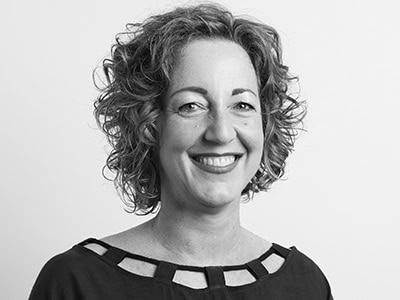- Still Point brought together only five necklaces and three brooches by Zoë Veness in a boutique experience at Gallery Funaki
- Close observation of the artist’s extraordinary folded-paper technique was possible
- The objects seemed to defy their materiality and have a theatricality or “stage presence”

Still Point
March 20–April 20, 2024
Gallery Funaki, Melbourne, Australia
On learning that jeweler Zoë Veness trained as a dancer at the Australian Ballet School before studying design, I realized that something in her work resonated with that of another Australian artist—Judith Wright, who also studied and practiced classical dance before becoming a visual artist. While both artists work in vastly different media[1] their respective practices reflect a deep knowledge of the discipline, strength, and poise required of a dancer’s body. They also have an innate understanding of composition and sculptural form, created in response to, and informed by, the body.
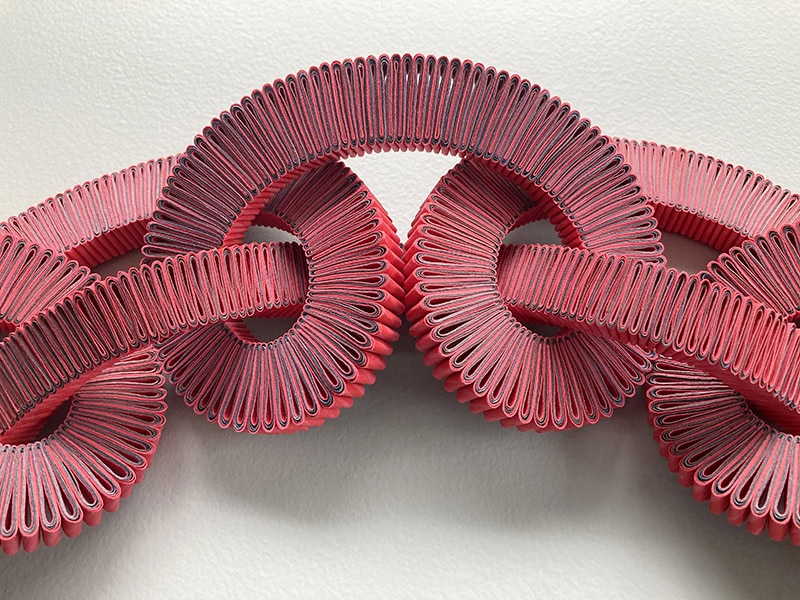
Within their works, the space between forms is also strangely captivating. It is as if the component parts are somehow held in suspense, just for a moment—deadly still, but always on the verge of movement. Indeed, when held, the entwined forms of Veness’s necklaces seem to want to wriggle from your hands.
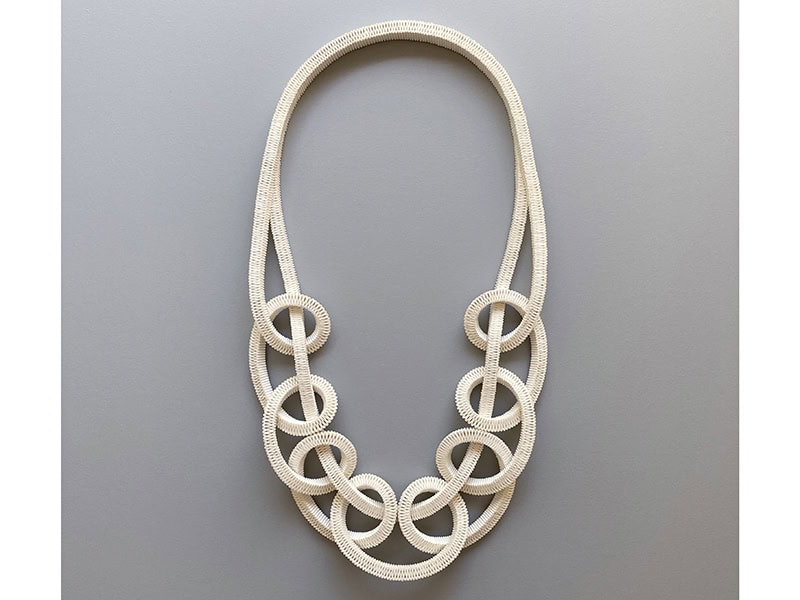
So it is not surprising that Veness’s exhibition, Still Point, was carefully calibrated. It brought together her work in the seemingly disparate materials of paper and metal in a boutique experience of just five necklaces and three brooches.
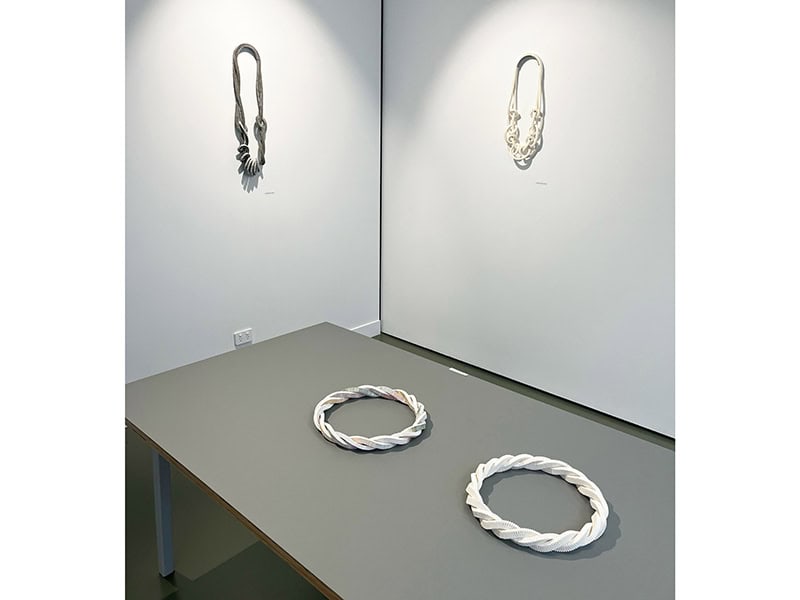
The two longer necklaces—Double Loop (2013) and Double Loop (2020)—were suspended on the wall. This highlighted the sinuous quality of the work’s design and gave a sense of how they would each lie against and mold to the body while worn. The remaining three works—Wreath (2020), Wreath II (2023), and Wreath (2024)—more choker-like in form, were displayed on tables. This allowed close observation of the artist’s extraordinary folded-paper technique.

Veness first developed her idiosyncratic approach while in residency at Edinburgh College of Art, in Scotland, in 2006. She has been refining her method of weaving tightly compressed folded strips of paper onto steel cable for close to 20 years. Based on detailed planning and precise mathematical equations, this practice is deeply iterative. The artist returns to previous designs as an impetus for experimentation that, in turn, fuels new work. As she has said:
This making process is experimental and reflective with looping and weaving systems and color combinations incrementally reworked to explore new ideas. The notion of a still point alludes to the sense of coherence I seek in my paper jewelry through harmonious synergies between the rhythmical patterns of the intricate folds, the contrasting materials of paper and silver, and the perpetual movement of the looped forms.[2]
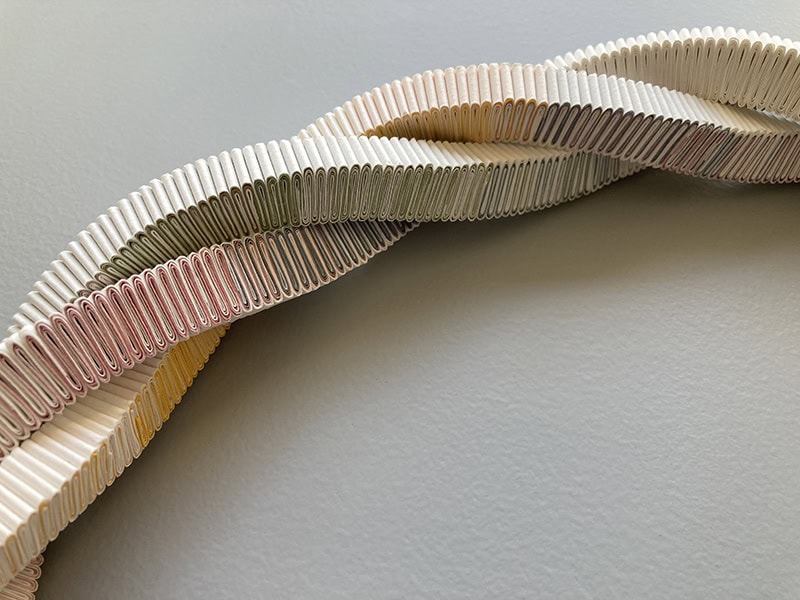
Originally, Veness used paper in her pieces to equate it to materials of jewelry that are traditionally viewed as precious and valuable (such as gold, silver, and gemstones). However, the dialogue now extends much further. These works also hold and convey a sense of time in their intricate construction, and in the repetitive but meditative act of making: of moving one’s hands in familiar and repeated patterns to create a sense of flow and space. At its best, this process can be described as a form of internal “stillness.”
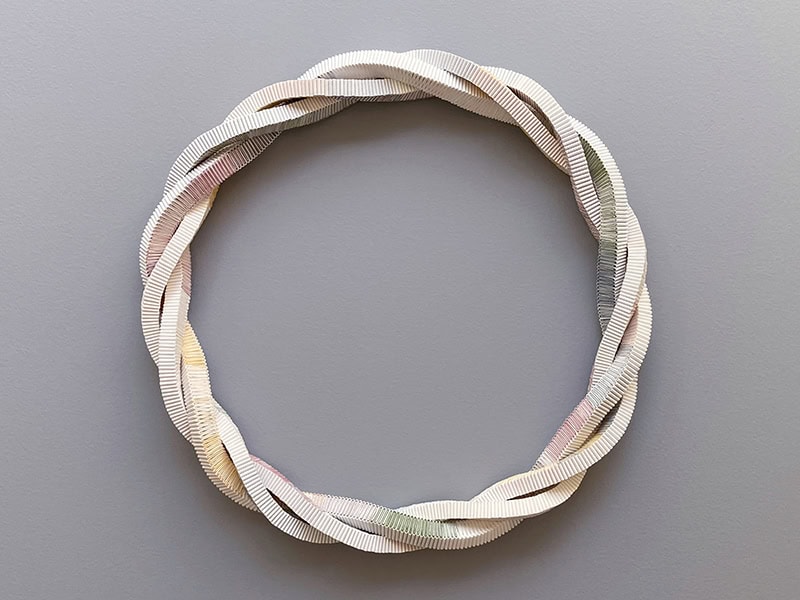
Neither humble in their construction nor physical presence, these objects seem to defy their materiality. They read as fabric rather than paper. Their soft pleated folds remind one of the elaborate ruffs popular in the mid-16th century. Think, for example, of the portraits of Queen Elizabeth I. In the same way, their color—both the soft pastel gradations of Wreath II or the bold red of Wreath (2024)—seems to have been dyed, rather than the result of the precise calculations of the artist and the act of weaving different strands of paper together.

Veness works with a range of colored cotton rag papers that are both acid-free and light resistant. She enjoys the conceptual challenges presented by the relatively limited range of hues available. In Wreath II, for example, the color shifts across each loop result from the artist “randomly” introducing different strands of colored paper into the weaving process. While a variation of millimeters can greatly affect a design and its outcome, Veness’s innate understanding of her technique ensures that her incorporation of color is not only seamless but appears to flow naturally from one area to the next. (A sense of movement is key).

While there is no doubt that these pieces would sit elegantly on the body and be a joy to wear, they have a theatricality or “stage presence” that clearly demonstrates their ability to stand on their own as small wearable sculptures. As the artist has explained:
Fundamentally jewelry is a supplemental form requiring the body to support it in order to function. Can jewelry therefore function without the body? What happens when the body is absent, such as the case when on display in an exhibition? How does this impact on the sculptural “presence” of the jewel? These are ongoing questions in my work.[3]
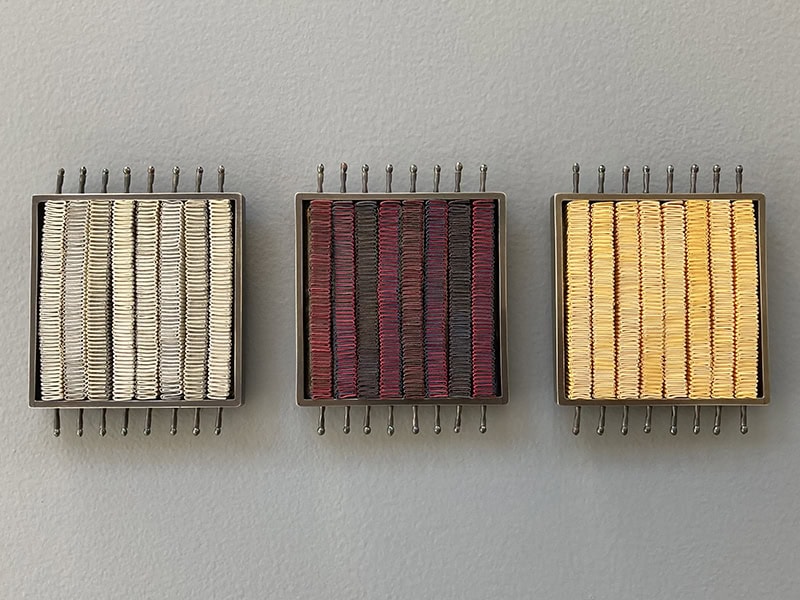
Three square brooches displayed on a shelf complete the exhibition.They bring together Veness’s work in metal with her dexterous, and in this instance, miniature, paper forms. (Each piece measures 2 ⅛ x 2 ¾ x ⅜ inches [53 x 69 x 10 mm]). The metal surround of each brooch serves as a container for the vertical paper “ribbons.” These designs differ from the sense of seamless continuity that appears in the necklaces. The rippling effect of the “fall” of the paper folds and the color gradations combine to create a subtle jostling effect. It feels as if the paper wants to break free from its metal surround. Again, Veness masterfully brings together the oppositional forces of stillness and potential movement. She creates works that engage and delight the eye, while rewarding both viewer and wearer.
Visit Gallery Funaki’s exhibition page here.

We welcome your comments on our publishing, and will publish letters that engage with our articles in a thoughtful and polite manner. Please submit letters to the editor electronically; do so here.
© 2024 Art Jewelry Forum. All rights reserved. Content may not be reproduced in whole or in part without permission. For reprint permission, contact info (at) artjewelryforum (dot) org
[1] Judith Wright’s work encompasses painting, drawing, video, sculpture, and installation.
[2] Zoë Veness artist statement, Zoë Veness: Still Point, Funaki Gallery, Melbourne, Australia, March 20–April 20, 2024.
[3] Zoë Veness quoted in “Zoë Veness,” Australian Design Centre, https://australiandesigncentre.com/past-exhibitions-and-events/madeworncontemporaryjewellery/zoe-veness/.
